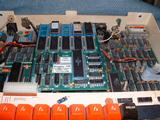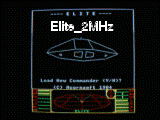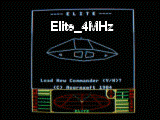
I've replaced the 4MHz select wires with supple ones on this board, and I'm going to add a yellow LED as with the 4MHz 32K board.
| [ Main index | Pictures of BBC computer related stuff | BBC add-on hardware | ] |
This sits nicely in the BBC: Installed in the 6502 socket, with 3 leads to switches 20,21,22, one to IC76 and one to R106. But it is a bit wide, so it won't fit with e.g. a Watford DDFS board. It's also a bit long, so fitting the keyboard cable is problem...

I've replaced the 4MHz select wires with supple ones on this board, and I'm going to add a yellow LED as with the 4MHz 32K board.
It didn't work at 4MHz at first, removing the board I found one of the wires (black/brown) to the speed switch had broken off. Solidisk used stiff cables to switches and solder points on all the boards I've seen (SWR/DFDC).

I've replaced the 4MHz select wires with supple ones on this board, and used a dual switch to also switch on a yellow LED when the computer is in 4MHz mode... (Image to follow)
Surprisingly, the 32K board is not as fast as the 256K board (see below for examples).
Visual speed test: Elite played in 2MHz and 4MHz (AVI format, 3 MB each; I think I tested this on the 32K board). Both clips are from the introduction starting at the moment the last program is loaded:
Elite in 2MHz:
Elite in 4MHz:

I estimate the Solidisk board runs Elite about 1.4 x faster at 4MHz than at 2MHz. Note that only the bottom 8K of RAM runs at 4MHz, along with all ROMs and SWR on the board. Other tests give much higher factors, including running BASIC programs.
Some examples (using BASIC 2 ROM placed on the Solidisk board so it will run at 4MHz):
Tests: (a) program is located in memory region 0-1FFF (b) program is located in memory region 2000-7FFF Test 2: Machine code program Test 3: Basic loop Test 4: Basic program that calculates the sine of 1-200 Prog\Times: Standard BBC Solidisk 4MHz 32K Solidisk 4MHz 256K T2a 1.12 0.56 0.55 T2b ,, 0.97 0.96 T3a 5.31 3.01 2.65 T3b ,, 3.04 2.66 T4a 4.99 2.94 2.49 T4b ,, 2.95 2.49
Btw, using Basic 4 from the master series is possible due to the 65C02, this will improve the sine calculation quite a bit; just 1.35s on the 4M-256K board.
| To email me, go to this page |
Last modified: Fri Nov 2 01:06:31 CET 2012